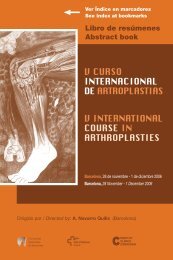Notas / Notes - Active Congress.......
Notas / Notes - Active Congress.......
Notas / Notes - Active Congress.......
Create successful ePaper yourself
Turn your PDF publications into a flip-book with our unique Google optimized e-Paper software.
MARTES / TUESDAY<br />
14<br />
09.00 - 10.45 h<br />
CADERA / HIP<br />
Pares de fricción y nuevos materiales / Friction couple and new materials<br />
Moderador: Victor M. Goldberg<br />
STUDY OF WEAR BEHAVIOR IN A HIP<br />
JOINT SIMULATOR OF DIFFERENT<br />
CoCrMo COUNTERFACES ON UHMWPE<br />
F. Javier Gil<br />
CREB. Dept. Ciencia de Materiales e Ingeniería Metalúrgica.<br />
ETSEIB. Universidad Politécnica de Cataluña.<br />
Barcelona (Spain)<br />
The objective in these wear tests was to study the effect of<br />
different material counterfaces on the UHMWPE wear behaviour.<br />
The materials used as counterfaces were based on<br />
CoCrMo: forged with hand polished and mass finished,<br />
CoCrMo coating applied on the forged CoCrMo alloy obtained<br />
by Physical Vapour Deposition (PVD). A Hip Joint Simulator<br />
have been designed and built for these studies. The worn<br />
surfaces were observed by optical and scanning electron<br />
microscopy. The results show that the hand polished CoCrMo<br />
alloy caused the higher UHMWPE wear of the acetabular<br />
cups. The CoCrMo coating causes the least UHMWPE wear,<br />
while the mass finished CoCrMo alloy causes an intermediate<br />
UHMWPE wear.<br />
MATERIAL AND METHODS<br />
The tests on the HJS wear test method were performed as<br />
follows (Figure 1). The acetabular cups were mounted on a<br />
home-made metal back support to transmit the load to each<br />
of the three stations. The cups were then pressed against<br />
the femoral heads. While the cups remains static, the heads<br />
slides according to the biaxial rocking motion. A constant<br />
load of 1000 N (102 Kg) per station was applied during the<br />
test. The frequency of the motion was 1.23 Hz (810 ms/cycle).<br />
In the HJS a cycle is considered as completion of one rotation<br />
of the head. The wear of the UHMWPE cups was determined<br />
by weight loss measurements every 333,333 cycles up to a<br />
total test length of 3 million cycles. The test lubricant was<br />
replaced with fresh solution after every weighing stop and<br />
distilled water was added during the test for compensating<br />
water evaporation. Each station has an environmental test<br />
chamber made of a transparent polycarbonate wall. Each<br />
chamber has been filled with 350 ml of lubricant. As test<br />
lubricant, a solution consisting of bovine serum and distilled<br />
water was used with a total protein concentration of 30 mg/ml.<br />
The serum was purchased at Sigma-Aldrich SrI (Calf serum,<br />
bovine donor; product No.C9676). The soak adsorption of<br />
the UHMWPE cups was determined using an additional<br />
control cup, which was loaded identically as the UHMWPE<br />
cups in the RPOF machine, but no motion was applied. The<br />
cleaning and drying of the UHMWPE cups was performed<br />
according to the ASTM 1715 standard. Weighing was carried<br />
out with a Mettler Toledo AT261DeltaRange® microbalance<br />
with an accuracy of 10±µg.<br />
Acetabular cups made of UHMWPE GUR1020 and previously<br />
sterilised with 25 KGy (2.5 Mrad) gamma radiation were<br />
used. The cups were supplied by the SAMO S.p.A. and<br />
received with their packaging, as they are commercialised.<br />
The cups are designed to be used with a metal back component<br />
and in conjunction with 28 mm femoral heads. The<br />
articulating counterfaces were therefore 28 mm femoral<br />
heads. Three different femoral head materials were studied,<br />
the standard material in this study was a hot-forged CoCrMo<br />
alloy. Table shows the chemical composition of this material<br />
and Table 2 the hardness and roughness of each material.<br />
· CoCrMo forged (hand polished)<br />
· CoCrMo forged (mass finished)<br />
· CoCrMo forged with a CoCrMo coating obtained by means<br />
of physical vapour deposition (PVD). The coating had the<br />
same chemical composition as the substrate.<br />
For each articulating counterface material three heads were<br />
tested. A total of 18 wear tests were performed. The test<br />
conditions and materials for the HJS wear tests are resumed<br />
in Table 3.<br />
RESULTS AND DISCUSSION<br />
The wear of the UHMWPE specimens (cups) in the HJS<br />
wear test method are shown in Figure 2, where the volumetric<br />
wear (mm3) of the UHMWPE cups is represented as a<br />
function of test duration in cycles for each the head material.<br />
The volumetric wear results are calculated from the average<br />
weight loss of three specimens.<br />
The results shown above after 3 million cycles present a<br />
high linearity and a low standard deviation. The standard<br />
deviation after 3 million cycles, represents for the hand<br />
polished alloy and the CoCrMo coating 10.20% and 4.66%<br />
respectively, and 6.95% for the mass finished alloy.





